AI Search Query Detector
Discover how much of your traffic and site impressions are generated by AI search and understand your visibility for AI search models.
AI search is reshaping the digital landscape. ChatGPT now processes over 780 million queries monthly, while Google handles 14 billion searches daily. Though AI search still represents only 2.5% of Google's volume, its rapid growth is fundamentally changing SEO expectations and user behavior.
Recently, Google started to provide data of the queries that AI generates when gathering information for their search results. We conducted extensive analysis on search query patterns to understand how AI-generated queries differs from human searches. Our research revealed distinct characteristics that make AI queries identifiable with high accuracy.
Key Research Findings
In this post, we'll walk through how to detect these AI queries manually and show you how our free tool can do it for you instantly. This tool applies our machine learning model to analyze your Google Search Console data, identifying which queries are likely AI-generated and providing insights on your visibility in the evolving search landscape.
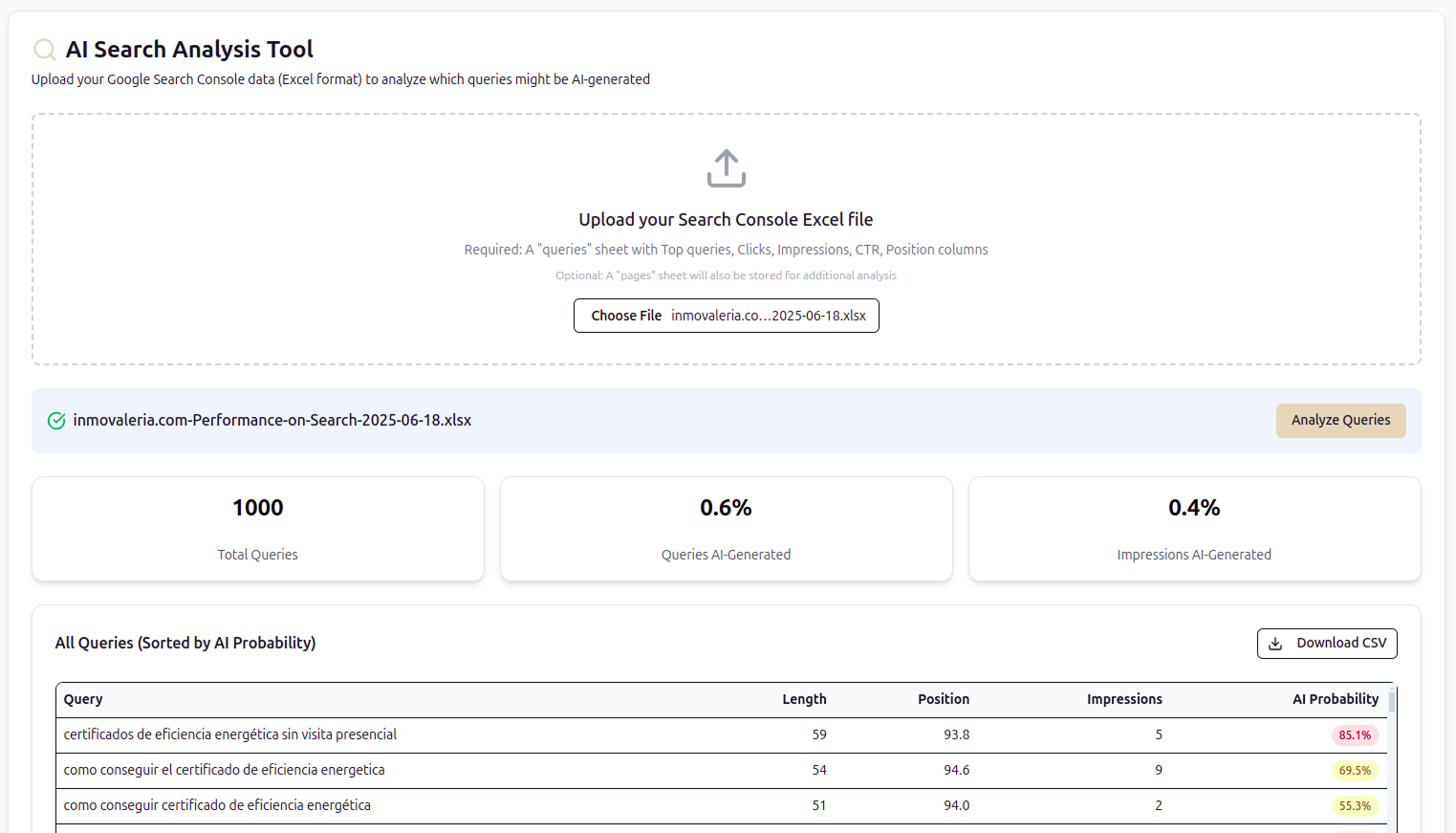
Analyze how many of your site impressions are generated by AI search
Upload your Search Console Excel file
Required: A "queries" sheet with Top queries, Clicks, Impressions, CTR, Position columns
Optional: A "pages" sheet will also be stored for additional analysis
How to Manually Detect AI Search Queries
Our Machine learning research confirms that while several factors play a role, some are far more predictive than others. Content length is overwhelmingly the most important signal, as shown by the feature importance analysis below.
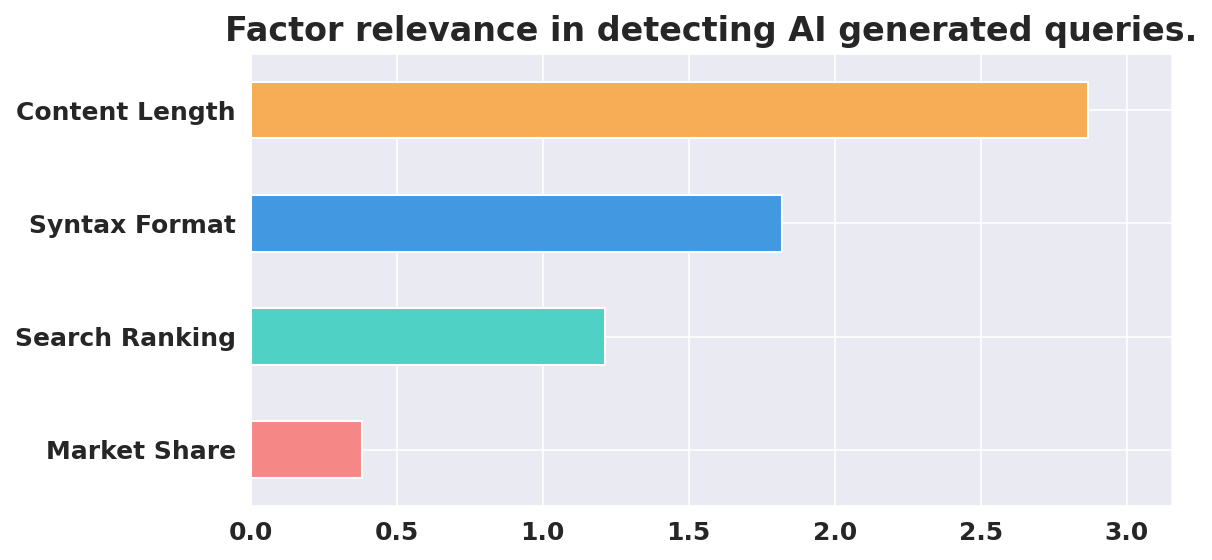
The strongest indicators for detecting AI-generated queries are length and structure. While other signals can point to AI activity, they are far less revealing. For instance, search position can be a minor indicator, our analysis shows a slight tendency for AI queries to cluster around rank 100, but it's a much weaker signal compared to the query's content.
Step 1: Go for the Long Queries
The single most reliable way to spot an AI query is its length. Our analysis shows that human searches are concise, averaging just 23 characters. AI, on the other hand, is verbose, with an average length of 45 characters.
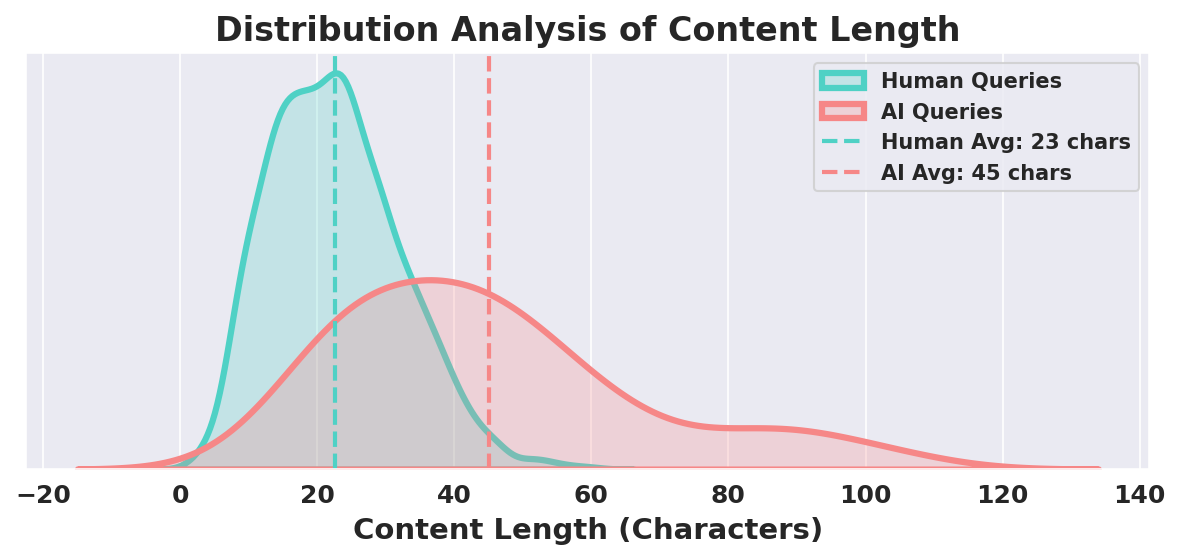
Queries over 50 characters have an 80% probability of being AI-generated.
Step 2: Look for Super Well-Structured Text
The second major clue is "perfect" syntax. Humans search conversationally, but AI constructs queries like a research assistant building a formal prompt. Our model identifies two formats: a formal, well-structured format and a more conversational, "interactive" format.
For example:
- AI:"semrush llm seo toolkit vs specialized geo platforms comparison"
- Human:"semrush seo vs alternatives"
The first query is a clear case of an AI-generated prompt due to its complexity and specific, formal structure. Sellm model would identify this as a query generated by AI.
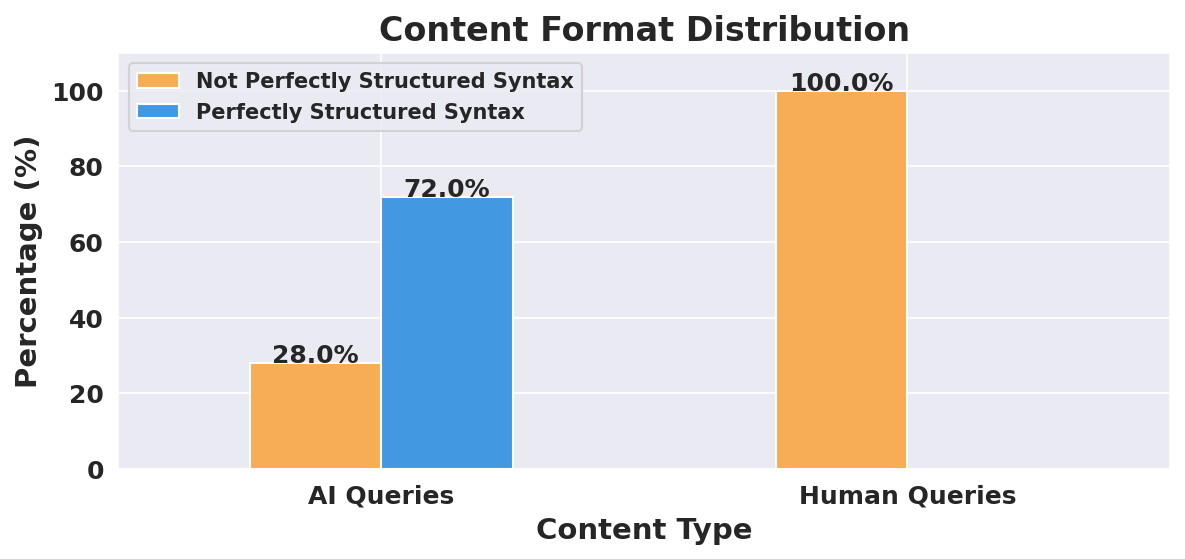
Look for queries that sound like they came from a machine, grammatically flawless, complex, and devoid of natural language quirks. This manual process is insightful, but to get the full picture instantly, you need an automated solution. That's where our tool comes in.
Step 3: Analyze Search Position (With Caution)
Position can be a hint, but it's a noisy signal. We see two interesting patterns: AI queries sometimes appear in very high positions with zero clicks (a sign of automated research), and they also cluster in low positions (around rank 100) with few views.
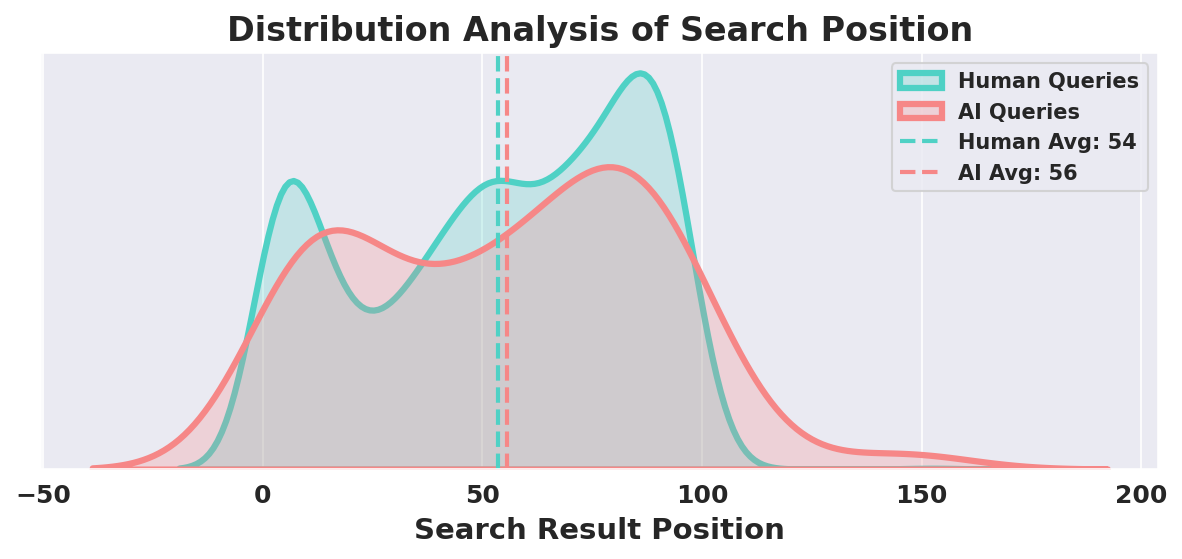
However, position by itself is not a reliable indicator. Use it as a secondary check after you've already identified a query as suspicious based on its length and structure.
How to Use the AI Search Checker Tool
Step 1: Download Your Google Search Console Data
First, you need your search query data. Go to your Google Search Console, navigate to the Performance report, and click the "Export" button in the top-right corner. Make sure to select Download Excel, as our tool is optimized for this format.
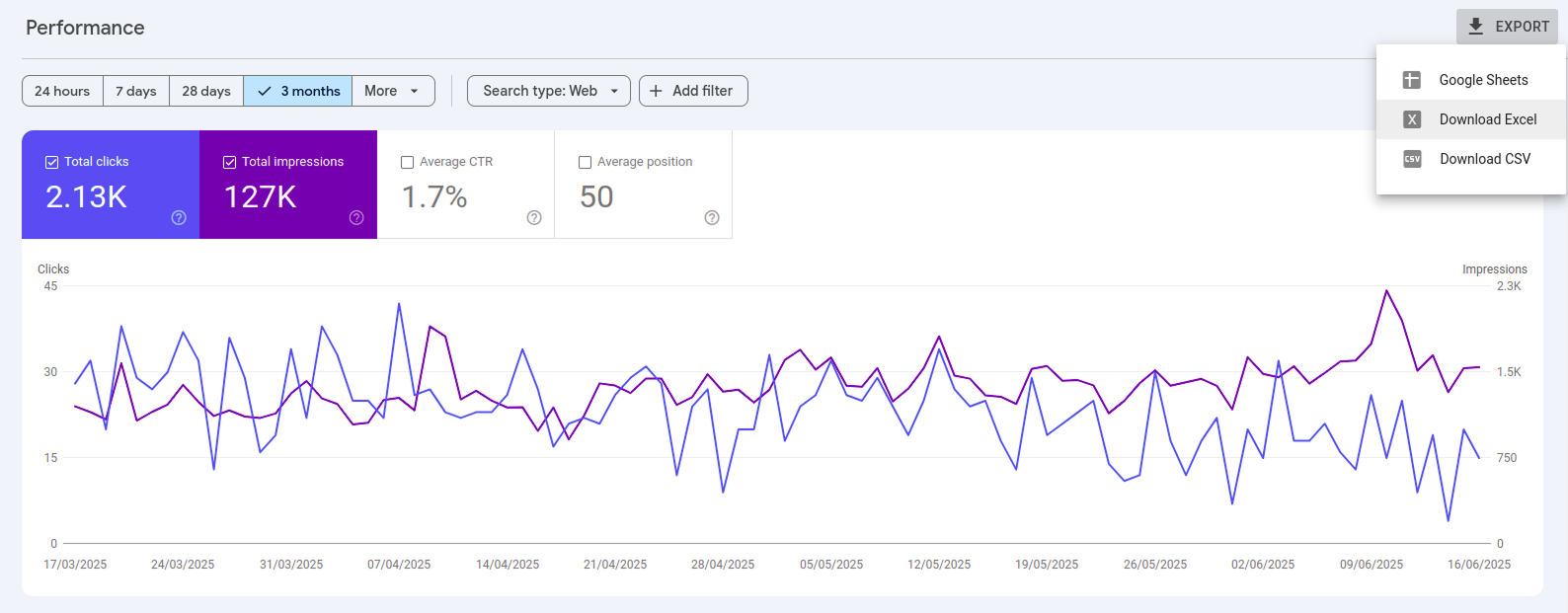
Step 2: Upload and Analyze
Once you have your file, simply upload it into the tool section at the top of this page. Our model will analyze your queries instantly and provide a complete breakdown.

Conclusion: Mastering AI Search Detection and Optimization
We have seen how to detect and track queries generated by AI, which is the first step to how can to optimize your content for AI search algorithms. By identifying AI-generated queries through their distinctive patterns, longer length, perfect syntax, and specific structural characteristics, you gain valuable insights into how AI systems interact with search content.
This AI Search Query Detector is one of our tools for generative search visibility. To get the complete picture of your AI search presenthece, other sellm free tools are:
- ChatGPT Presence Audit: If you want to "audit your brand's presence in ChatGPT answers", our GEO audit tool analyzes how your brand appears in AI-generated responses.
- ChatGPT Share of Voice Tool: Track how many times your brand is being mentioned by ChatGPT during training and in real-time responses, giving you insights into your competitive position in the AI landscape.
Together, these tools provide a complete view of your generative search visibility, helping you optimize your content strategy for the AI-powered search future.
The Future of AI Search Detection
The line between human and AI search is blurring, and the landscape is evolving at an unprecedented pace. Staying ahead requires understanding where search is going.
- It Will Get Harder to Distinguish: As AI models become more sophisticated, their queries will more closely mimic human search patterns. Simple indicators like length and structure will become less reliable, requiring more advanced semantic analysis to tell them apart.
- Zero-Click is the New Standard: AI-powered search provides direct answers, meaning users no longer need to click through to websites. The goal is shifting from driving traffic to being the source of the answer itself. Success will be measured by how often your data is used in AI responses, not by clicks.
- Brand Presence and Citations Are the New Metrics: In a zero-click world, the most important metrics are brand mentions and citations within AI answers. The new SEO is Generative Engine Optimization (GEO), ensuring your brand is visible and cited when AI engines answer questions about your market.
Tracking these new metrics is the key to a successful strategy in the age of AI search. Our tools are built to provide exactly these kinds of insights.